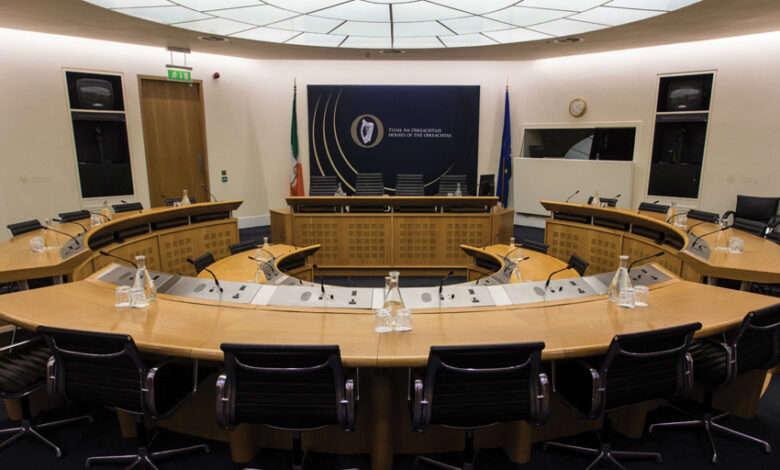Joint Committee on Justice: 2023 work programme

Published in January 2023, the Oireachtas’ Joint Committee on Justice’s work programme for 2023 sets out the work that the committee is currently engaged in and will undertake for the remainder of the year.
The Work Programme of the Joint Committee on Justice was agreed by the committee on 18 January 2023 and presented to both houses of the Oireachtas. Chief among the responsibilities on the committee’s work programme is the performance of pre-legislative scrutiny. Under Standing Order 174A(1), the general scheme or draft heads of a bill are given to the committee by a member of the Government or Minister of State.
The Government’s Legislative Programme for Autumn 2022 identified three government bills relevant to the Department of Justice, and thus relevant to the committee.
The first bill listed on the programme was the Criminal Justice (Sexual Offences and Human Trafficking) Bill 2022, for which the Joint Committee on Justice convened for pre-legislative scrutiny on 6 December 2022, hearing submissions from the Immigrant Council of Ireland, Irish Human Rights and Equality Commission, Rape Crisis Network Ireland, Migrant Rights Centre Ireland, Michael Breen, Michael Healy, and Amy Healy of Mary Immaculate College, and officials from the Department of Justice. The committee issued its report on the pre-legislative scrutiny on 8 March 2023, issuing 25 recommendations including that a specific victim-centred identification process for child victims of trafficking be established, that the legislation should state more clearly the supports that will be offered to victims, and that an appeal mechanism should be provided under the legislation.
8 March 2023 also saw the publication of the committee’s report stemming from its pre-legislative scrutiny of the Inspection of Places of Detention Bill 2022, which carried with it 21 recommendations. The committee formulated these recommendations after having met on 17 October 2022, hearing submissions from the Irish Council for Civil Liberties, the Irish Penal Reform Trust, Joe Garrihy of Maynooth University, the Mental Health Commission, the Prison Visiting Committee, officials from the Department of Justice, and the Office of the Inspector of Prisons. Among the committee’s recommendations were the immediate ratification of the Optional Protocol to the UN Convention against Torture, that the legislation provide more detail on how detainees’ voices will be heard during investigations, and that a separate and independent body should be tasked with deciding on the categorisation of a prisoner’s complaint, rather than the Irish Prison Service.
The third of the government bills mentioned within the work programme, the Sale of Alcohol Bill 2022, had its pre-legislative scrutiny report published on 2 March 2023. The publication of this report showed a much shorter turnaround time from the holding of the scrutiny, with the committee having performed said scrutiny on 24 January 2023. The committee heard from representatives of the Licensed Vintners Association, Give Us the Night, the Vintners’ Federation of Ireland, Independent Craft Brewers of Ireland, Music and Entertainment Association of Ireland, and officials from the Department of Justice in an effort to gauge views regarding the bill that will create one single piece of legislation to regulate the sale of alcohol. The committee’s report returned 27 recommendations, including the amendment of the bill’s title to better reflect the broader impact of the legislation, the creation of a new type of venue license for dance venues separate from the seven-day publican’s license, and that consideration be given to the introduction of a form of ‘dry license’ for venues that are open during the night-time hours but not serving alcohol, along with hybrid licenses for venues that serve alcohol at certain times but wish to remain open beyond those times.
| Joint Committee on Justice |
|
Five private members’ bills have also been referred to the committee:
- Regulation of Private Security Firms Bill 2019;
- Proceeds of Crime (Investment in Disadvantaged Communities) (Amendment) Bill 2021;
- Civil Liability and Courts (Amendment) Bill 2021;
- Firearms and Offensive Weapons (Amendment) Bill 2021; and
- Coercion of a Minor (Misuse of Drugs Amendment) Bill 2022.
The select committee within the committee will also be tasked with the consideration of the Minister’s estimates for public spending, although the select committee is not empowered to amend these estimates. The select committee is expected to deal with the Revised Estimates for Public Services in 2023, including estimates for An Garda Síochána, prisons, the Courts Service, the Department of Justice, the Policing Authority, and the Data Protection Commission.
In doing so, the committee has affirmed its intention to focus on: what the department has committed to achieving; how money is allocated between services; and “exploring the policy issues underpinning the various spending provisions as well as to consider these matters as fully as possible”.





